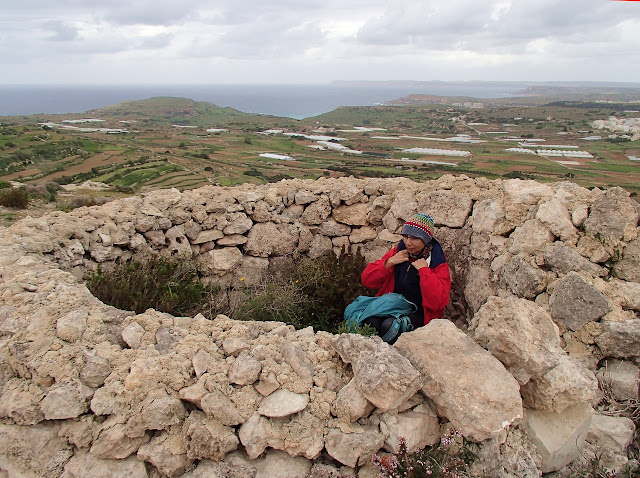Given how much fun it has been driving in the urban areas of Malta, we thought we would head north away from the population centers of Saint Julians and Valleta. The only major center along the route is Saint Paul's Bay and we mostly managed to bypass this.
We had read about a hike along the most northern peninsula on the main island called Marfa Ridge, so armed with a trail map on our cell phone we drove to Ghadira (pronounced A-deer-a) Bay. Just short of the trail head we stopped at a resort supermarket to buy bread, cheese and fruit for a picnic lunch. The cashiers were very friendly and we discussed the complex roots of the Maltese language - Arabic, English, French, Italian, etc - a product of the many invasions that have shaped Malta.
 |
| Our rental Picanto |
It would probably have been a good idea to review the hiking notes before beginning this hike, but we hadn't, and soon realised that we were starting at the trail end. As in yesterday's walk, we ended up off the described route and for a few hours the only people we encountered were one group of local hikers and a Maltese/Canadian named Joe working on his land holding. We found ourselves on a path used by the farmers to access their fields of crops (which are limited here due to the arid conditions and poor soil). These common paths wind their way between hundreds of private land holdings and may continue for miles. As we walked further on this path, we came to wilder, more rugged terrain where some scrambling was required.
 |
| Path between furrowed farmers' fields |
 |
| Limestone shelves and giant boulders |
 |
| Little Rani, Big Boulder |
 |
| A patch of eroded clay that reminded us of the hoodoos in the Canadian or US west |
The views of the west coast from the limestone cliffs were superb. There were fossils embedded in the ledges and shelves we crossed and a sea breeze kept us cool throughout. In the summer, we would have been tempted to bathe in the secluded inlets, but getting in and out of the ocean would have been exciting because the limestone is very rough. There were large patches of yellow wildflowers, a few palm trees and even a tiny forest of bamboo in clay soil.
 |
| Coastal panorama |
 |
| Fossilized sand dollar |
 |
| Golden flowers - maybe creeping wood sorrel? |
We stopped briefly at St. Agatha's Tower, a red ochre watchtower built in 1657, one of a chain of such towers on the north and east coasts used by the Knights of Malta during the 17th and 18th centuries. It overlooks the potential enemy landing sites at Mellielha Bay and has a commanding view of the islands of Comino and Gozo. Unfortunately, like many of the tourist sites in Malta, it was closed to visitors!
 |
| St. Agatha's Tower |
Along the trail we came across beehive shaped corbelled huts, called
girna, that are constructed from loose rocks and stones gathered from the local
garrue (scrub land). These and their more common rectangular cousins, roofed with wood or panels, may look primitive, but they are very sturdy and provide shelter for the farmers from the elements. Some are also grouped together to shelter animals.
 |
| Rani looking towards Gozo (note the corbelled hut behind me) |
 |
| A crude rock hut shelter. If you look closely you will see that the photographer accidentally made Rani's legs turn to stone! |
The Maltese islands used to be covered in trees but when man arrived 7000 years ago, the forests were cleared for farming and the wood used for fires, leaving very few patches of forest. There is an effort to regrow trees in some areas by non-profit organizations such as BirdLife Malta, and we passed through several conservation areas on our hike. We saw replantings of Aleppo pines among the ubiquitous olive trees. Hopefully these will attract more birds.
We decided to forego the opportunity to visit the reverse osmosis plant and ferry terminal, and drove instead to the end of the road for a walk along the cliffs above Slugs Cove. Signs of erosion and a memorial here kept us (mostly) at a safe distance from the edge.
 |
| View towards Gozo island |
Posted by Rani...

















































